
The Ukraine war crisis has now been labeled as “Modi’s war.” After imposing a primary tariff of 25% on India, the US has now introduced an additional 25% secondary tariff. Excuse me, Mr. Trump and your administration… the impact of tariffs will be faced by US also.
The reason given for the initial 25% tariff was that India practices protectionism. But you should know that India is a developing nation, while the US is a developed nation. Developing nations often use tariffs (taxes on imports) and subsidies (government financial support) to protect their domestic industries from foreign competition. For instance, India has strategically employed tariffs to protect its domestic sectors and promote self-reliance. And Mr. Trump, if your policies are not protectionist(for a developed nation), then what are they?
For the secondary tariff, the justification given was that India has not stopped importing oil from Russia and is indirectly supporting the war. But let’s be clear—China is also importing oil from Russia. So why are all the sanctions targeted only at India? Moreover, the US itself continues to trade with Russia, even if the volume has decreased significantly. How can this double standard be justified?
Is impact of tariffs not visible to IOs?
At this point, organizations like the WTO and other international bodies responsible for safeguarding the interests of developing nations should think about the impact of tariffs and must step up strongly and firmly. Otherwise, all developing nations should unite and step back against such organisations.
As Mr. Jaishankar rightly said in an interview, “Europe’s problems are not the world’s problems.” Exactly! And if India is accused of supporting the war, then what about the US supporting Pakistan, a country that has been linked to terrorism? Supporting a war may happen sometimes in history—nations often take sides—but supporting terrorism is absolutely unacceptable. However India is not supporting any war. India is ready to bear impact of tariffs and to work in direction of strengthening economy but not to accept terrorism and weakening of domestic market.
If this logic holds, then the US should first stop trading with Pakistan. And what about the war in Israel and Palestine? Has the US stopped trade there? No. It’s true that these strained relations may hurt India significantly and impact of tariffs is absolutely visible, but, not India alone, the US will also suffer substantial losses.
Calculating the impact of tariffs
Now, how can we estimate the impact of tariffs on different sectors? For that, we need to look at three factors:
- How much the US imports from India in that particular sector.
- The US share in India’s total exports for that sector.
- Most importantly, the tariff percentage imposed on that sector.
If the US share in a sector’s exports is high, the impact will be greater; if it’s low, the impact will be minimal.
Sectors having worst Impact of Tariffs
The Worst impact of tariffs are in these sectors:-
Shrimps: In FY2025, India shipped shrimps worth $2.4 billion to the United States, representing 32.4% of its total shrimp exports. US imposed only 10% tariff earlier, now it is 60%(way too much).
Textiles and Apparel: In FY2025, India exported textiles and apparel worth $10.8 billion to the US, with apparel alone contributing $5.4 billion. The US makes up 35% of India’s apparel exports. Tariffs will surge from 13.9% to 63.9%. This will severely hit production clusters in Tiruppur, Noida-Gurugram, Bengaluru, Ludhiana, and Jaipur, while countries like Bangladesh, Vietnam, Mexico, and CAFTA-DR members are likely to replace Indian suppliers.
Leather and Footwear: Exports of leather goods and footwear to the US are worth $1.2 billion but will now face a steep 50% tariff. This will erode India’s competitiveness against Vietnam, China, Indonesia, and Mexico, hitting major production centers such as Agra, Kanpur, and the Ambur-Ranipet belt in Tamil Nadu.
Gems and Jewellery: Exports of gems and jewellery to the US touched $10 billion, accounting for 40% of India’s worldwide trade in this segment. However, tariffs are risen from 2.1% to 52.1%, putting millions of jobs at risk in Surat, Mumbai, and Jaipur—key hubs for cutting, polishing, and manufacturing.
Carpets: Carpet exports to the US stood at $1.2 billion in FY2025, with the American market holding a 58.6% share. Tariffs have increased from 2.9% to 52.9%, endangering artisan livelihoods in Bhadohi, Mirzapur, and Srinagar, while rivals like Turkey, Pakistan, Nepal, and China gain ground.
Handicrafts: India’s handicraft exports to the US were valued at $1.6 billion in FY2025, with a 40% share in overall exports. Rising duties threaten to shut down factories in Jodhpur, Jaipur, Moradabad, and Saharanpur, paving the way for Vietnam, China, Turkey, and Mexico to capture the market.
Agriculture and Processed Food: India ships basmati rice, tea, spices, and other agricultural products worth $6 billion to the US. These will now attract a 50% duty, opening the door for competitors like Pakistan, Thailand, Vietnam, Kenya, and Sri Lanka to dominate US demand.
Modest impact of tariffs are on organic chemicals(13.2% share and tariffs raised from 4% to 54%), steel, aluminium and copper, and machinery and mechanical appliances sectors.
Government Actions
Government is again focusing on SWADESHI and VOCAL FOR LOCAL. This will help in two ways. First it will reduce the export dependencies and will strengthen our own industries and sectors. Government is also looking forward to diversify the trade destinations and use the FTA(Free Trade Agreement) Deals effectively. These measures have potential to significantly lower the impact of tariffs.
This is the high time when we should also take a step forward and GO VOCAL FOR LOCAL to support our country.
READ MORE:-Do we really not need RESERVATION?

